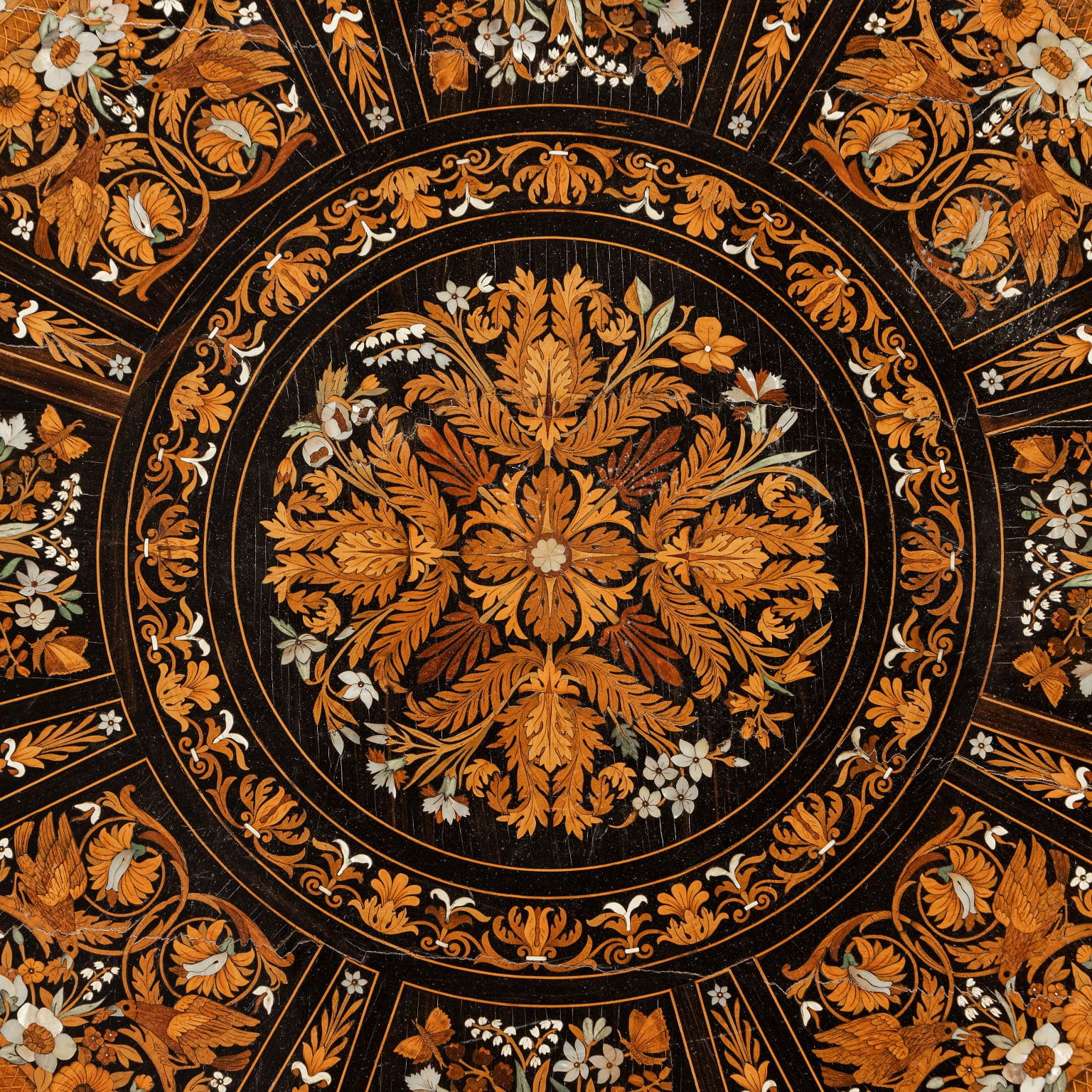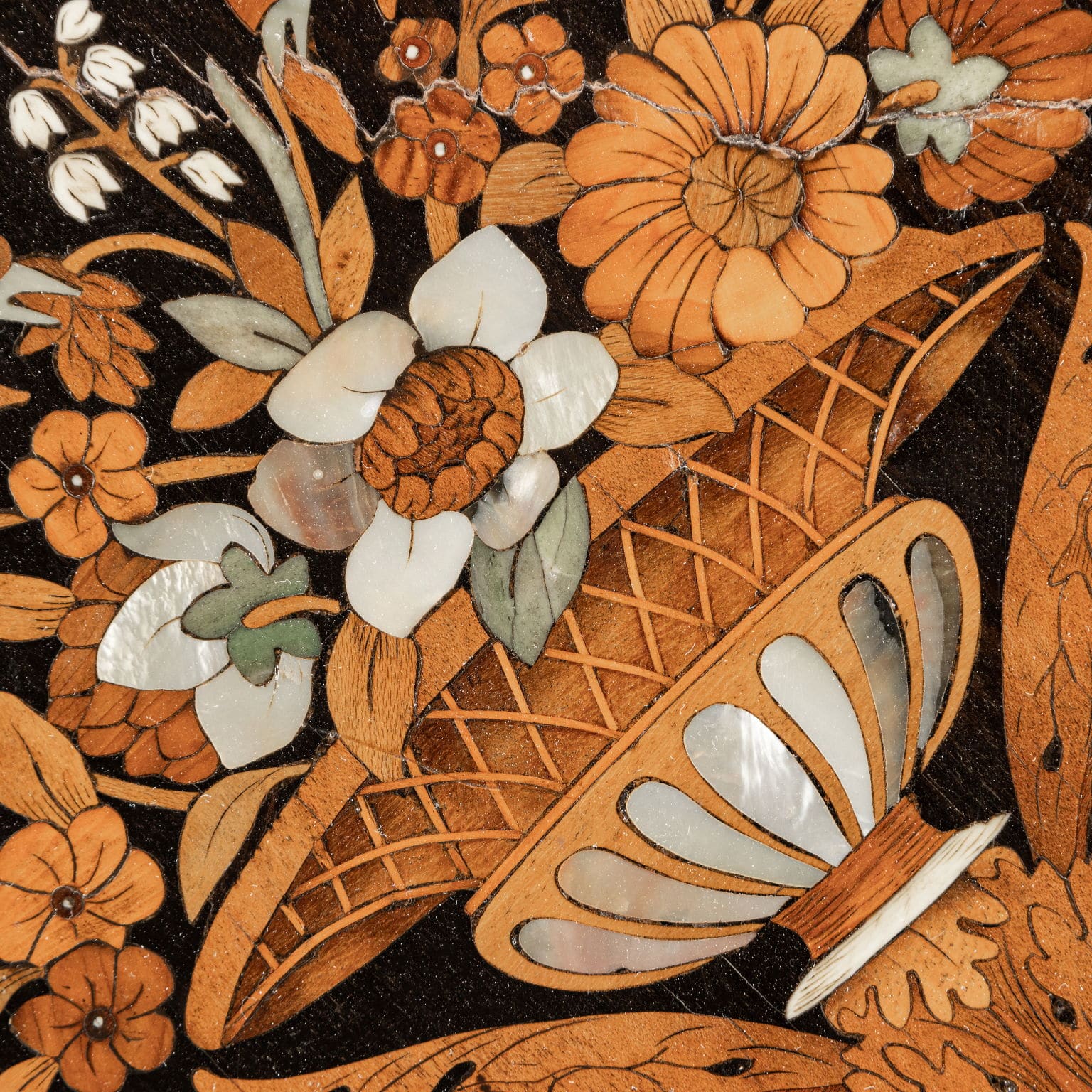- Sail Table, attributable to Luigi and Angiolo Falcini, Florence, second quarter of the 19th century
Sail table with octagonal top veneered in dark walnut and inlaid with woods various, mother of pearl and bone. The plan has in the center a reserve inlaid with a rose window and surrounded from a border with phytomorphic motifs; around it develop, in wedges, narrower reserves where there are inlaid candelabras with vases and eight larger reserves where vases with bouquets of flowers animated by birds and moths. The shaped base is composed of four columns which hold the support for the top which is veneered in wedges on the back mahogany.
Dimensions: 78 x 152 cm ( 30,7 x 59,8 in )
CODE: ANTATA0128592
The Falcini brothers’ workshop brings the taste for seventeenth-century inlay back to Florence; as Palacios writes “… they seem to be based on the dominant taste of the court of the last Medici and the ornamental repertoire seems to have been taken away from the flowery calepini used by the commissioners of semi-precious stones or by the cabinetmakers headed by Leonardo Van der Vinne …”.
They will mainly focus on the production of table tops that will be made for the great families of Florence and sent to major exhibitions all over the world. Palacios is also the first to present a series of tables with an octagonal base, mostly small tables, between 80 and 100 cm. The taste and motifs are the same, mostly vases and bouquets of flowers animated by birds and butterflies, made with different types of light woods, ivory and mother of pearl on a dark background. Among these stands a table of extraordinary dimensions of 167 cm in diameter where, as Palacios always writes “… on the top, centered by a noble coat of arms, garlands and concentric floral friezes with radial segments alternate that host four different decorative motifs with vases, candelabra , dolphins and birds pecking fruit and flowers… “.
This decorative apparatus, with the exception of the central rose window with the coat of arms, is also used for the table in question as well as for another table published by Simone Chiarugi, auctioned in London with the Troubetzekoy family coat of arms in the center. All three are large tables. The workshop was mainly dedicated to the inlay of tops and sometimes the bases of the tables are simple, without inlays, while other times they are probably carved by Florentine carvers’ workshops, as hypothesized by Simone Chiarugi.


For the sake of accuracy, it should be noted that the table in question here was also published by Enrico Colle in the chapter dedicated to the Falcini brothers, however given to a shop of imitators together with another table, instead always brought back to the Falcini family by Simone Chiarugi. Although having to remain in the field of attributions, having no signatures or inventory documents that guarantee paternity, it seems to us that we can say with some certainty that the table described here has been fired from the Falcini brothers’ workshop.
The known repertoire leads us to believe that these artisans, like all the workshops of the time, created more works with the same designs available, modifying part of the ornamentation or inserting them in a different way, while it seems rather difficult that there was a contemporary workshop of emulators that produced tables with the same identical designs.
– Alvar González-Palacios, Il Tempio del Gusto, La Toscana e l’Italia Settentrionale, ed. Longanesi 1986;
– Simone Chiarugi, Botteghe di Mobilieri in toscana, ed. S.P.E.S. 1994;
– Enrico colle, Il mobile dell’Ottocento in Italia, ed. Electa 2007

FineArt is the new ambitious Di Mano in Mano project that offers an exclusive choice of antiques and design works, presenting them for their singularity and uniqueness.

FineArt by Di Mano in Mano is a team of experts at your service to enhance furniture, paintings, finest antiques, art and design masterpieces at best.
Di Mano in Mano
Via Castellazzo 8, Cambiago (MI)
20040